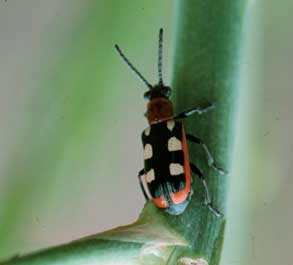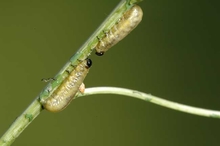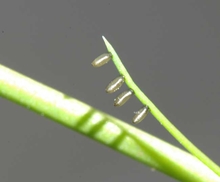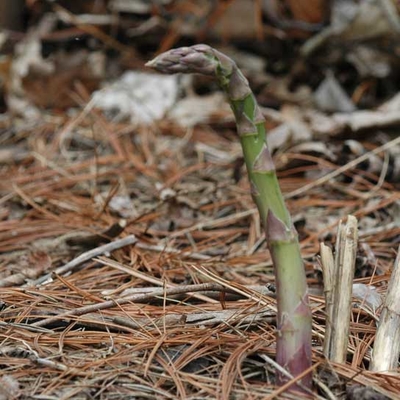Quick facts
- The common asparagus beetle and the spotted asparagus beetle feed on asparagus spears and cause browning and scarring.
- Start looking for these pests in early May or just after asparagus plants emerge and continue for the rest of the growing season.
- The best time to check for asparagus beetles is in the afternoon when they are most active.
- You can manage common asparagus beetles by handpicking them and dropping them in a pail of soapy water.
- If you find a lot of asparagus beetles in your garden you may want to use a pesticide.
How to identify asparagus beetles
It is important to correctly identify the two different kinds of asparagus beetles because the common asparagus beetle is found more often and causes more damage.
Both types of asparagus beetle adults are ¼-inch long with oval-shaped bodies and moderate-length antennae.
- The adult common asparagus beetle (Crioceris asparagi) is bluish-black with six cream-colored spots on its back.
- Adult spotted asparagus beetles (Crioceris duodecimpunctata) are reddish-orange with twelve black spots.
The larvae of both species are slug-like with visible heads and legs.
- Common asparagus beetle larvae are light gray with a black head.
- Spotted asparagus beetle larvae are orange.
Spotted asparagus beetles should not be confused with beneficial lady beetles.
Lady beetle adults have oval to rounded, dome-shaped bodies with a varying number of spots. They also have heads that are partly to completely hidden when viewed from above and short antennae.
Biology
Common asparagus beetle adults live through the winter in sheltered places such as in the hollow stems of asparagus plants or in leaf residues. Adults appear in gardens just as the asparagus spears are coming out of the soil in spring.
The beetles lay many dark brown, oval-shaped eggs in rows on the spears, ferns or flower buds of asparagus plants.
- The eggs hatch within a week.
- The larvae move to the ferns to start feeding.
- They feed for about two weeks and then fall to the ground to transform into pupae in the soil.
- About a week later, adults emerge to start another generation, feeding on the ferns for the rest of the growing season.
The spotted asparagus beetle has a similar life cycle but usually appears in gardens later than the common asparagus beetle in mid-May. It is gone by late July.
They lay greenish eggs on the ferns. The orange larvae feed on the berries of the asparagus.
Damage caused by asparagus beetles
Asparagus spears become brown and bend over into a hook when either species of asparagus beetle adults feed on the spears.
Once the ferns appear after the harvest of asparagus, the common asparagus beetle larvae and adults can also feed on the ferns.
Beetles feeding on the leaves weaken the plant and reduce the plant's ability to provide sufficient nutrients for the following season. Fewer leaves also make asparagus a target for Fusarium, a fungal disease.
The spotted asparagus beetle larvae feed on asparagus berries and do not affect the health of the plant. The presence of common asparagus beetle eggs on the spears can make the asparagus unappealing.
Managing asparagus beetles in gardens
Monitoring
- Start looking for signs of beetles on plants in early May or just after asparagus plants emerge and continue checking throughout the growing season.
- Check for asparagus beetle infestation when they are most active, which is on warm, sunny afternoons.
Cultural controls
- Asparagus beetles spend the winter in asparagus patches.
- Remove ferns in the fall once they are completely brown.
- If snow falls before plants are brown, remove dead ferns as soon as possible in the spring.
- Remove dead ferns from the growing area.
Physical controls
- Handpicking, especially in small gardens, can be effective.
- Drop adults and larvae in a pail filled with soapy water.
- Remove the dark brown eggs from the spears.
- New adult beetles can fly into the garden, so be sure to check your asparagus regularly.
Biological controls
You may notice a tiny metallic green wasp (Tetrastichus asparagi) when working in your garden. These wasps parasitize asparagus beetle eggs (the wasp larvae live and feed inside the beetle eggs). They can kill up to 70% of the eggs.
Lady beetle larvae and other predators may also be active and will eat both eggs and larvae. Leave these beneficial insects alone and they can reduce the number of beetles eating your asparagus.
Pesticides kill beneficial predators and parasites, so be careful if you decide to use them.
Using pesticides
Protect your plants with a pesticide if:
- 10% or more of your plants have either species of adult asparagus beetles.
- 50 to 75% of the plants have common asparagus beetle larvae.
- 20% or more of spears have dark brown, oval-shaped eggs on them.
You can find the common name for a pesticide by reading the active Ingredients on the label (this is usually in small print).
Common names of active ingredients:
- Pyrethrins (effective less than one day)
- Neem (effective for several days)
- Spinosad (effective for about one week)
- Malathion (effective for about one week)
- Carbaryl (effective for about one to two weeks)
- Pyrethroids, including permethrin, lambda cyhalothrin and cyfluthrin (effective for two to three weeks)
The pesticide must be labeled for use on asparagus or vegetables. Be sure to observe the number of days between pesticide application and when you can harvest the asparagus.
These pesticides are generally toxic to honey bees, so avoid spraying when asparagus or other plants are flowering. Even if bees do not pollinate asparagus, they sometimes visit asparagus during bloom. It is better to spray very early in the morning or in the evening when the bees are not gathering nectar or pollen as actively.
CAUTION: Mention of a pesticide or use of a pesticide label is for educational purposes only. Always follow the pesticide label directions attached to the pesticide container you are using. Be sure that the plant you wish to treat is listed on the label of the pesticide you intend to use. And observe the number of days between pesticide application and when you can harvest your crop. Remember, the label is the law.
Managing asparagus beetles on farms
Monitoring
- Start looking for signs of beetles on plants in early May or just after asparagus plants emerge and continue checking throughout the growing season.
- Beetles are most active on sunny afternoons.
- Scouting between noon and 6 p.m. will give you the most accurate estimate of infestation levels.
Cultural controls
- Research suggests asparagus beetles spend the winter in the field. Remove ferns once they are completely brown, which shows they are dormant.
- Asparagus may not be fully dormant before snow falls. If this is the case remove ferns from the field or burn them in the spring.
- If dealing with consistently high asparagus beetle populations, remove other residue in the field like straw, residue, and cover crops.
- Harvest promptly and regularly to reduce egg-laying spots.
Biological controls
- A tiny metallic green wasp (Tetrastichus asparagi) parasitizes asparagus beetle eggs They can kill up to 70% of the eggs.
- Lady beetle larvae and other predators may also be active and will eat both eggs and larvae.
- Pesticides kill beneficial predators and parasitoids.
Using insecticides
Thresholds and considerations for insecticide use are different for spears and ferns.
For spears
- The treatment threshold is 5-10% of spears are infested, or 2% of spears have eggs on them.
- Any product that you do use needs to have a short Pre-Harvest Interval (PHI). This varies with each product, and for many products can be too long to allow for spear harvest.
- The Midwest Vegetable Production Guide can be used to quickly find options that work in asparagus beetles and have a shorter PHI.
- Asparagus beetles are most active on warm sunny afternoons. , which is often when asparagus is being picked. If you are seeing significant damage, sacrifice a picking to ensure that the most beetles possible are contacting your spray.
- New spears are not protected by insecticides that were sprayed before their emergence. After applying your first spray, scout the crop regularly to see if asparagus beetles or eggs appear again.
- Rotate insecticide modes of action to stay under the maximum allowable rates for each insecticide.
For ferns
- A threshold is 50-75% of ferns infested.
- Tread carefully, as flowering asparagus ferns are attractive to bees, so these applications have to be timed carefully.
- Rotate insecticide modes of action to stay under the maximum allowable rates for each insecticide.
For current products for asparagus beetles, see the Midwest Vegetable Production Guide.
Reviewed in 2024






